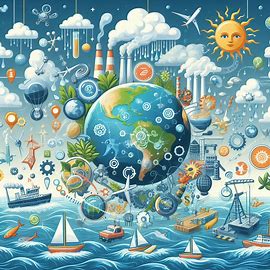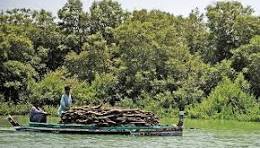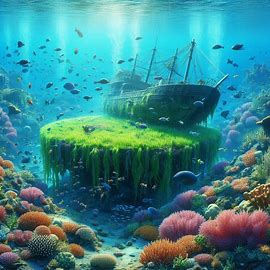Climate Change 2025:Unlocking Adaptable Ocean Solutions for Climate Action
Climate change is one of the most pressing challenges of our time, and our oceans hold immense potential in combating this crisis. As the world’s largest carbon sink, the oceans play a crucial role in regulating the Earth’s climate. This blog post will delve into the various ocean solutions that can significantly contribute to climate action, from sustainable fisheries to innovative technologies. Let’s explore how harnessing the power of our oceans can help mitigate climate change and secure a sustainable future.

1. The Role of Ocean Solutions in Climate Regulation
- Oceans as Carbon Sinks: Oceans absorb approximately 25% of the CO2 emitted by human activities annually, making them the planet’s largest carbon sink1. This natural process helps mitigate the effects of climate change by reducing the amount of CO2 in the atmosphere. However, the increased absorption of CO2 is causing ocean acidification, which poses a threat to marine ecosystems2.
Thermal Regulation: The oceans absorb and distribute heat around the globe, playing a vital role in maintaining temperature balance. Ocean currents transport warm water from the equator to the poles and cold water from the poles to the equator, helping to stabilize global temperatures and weather patterns3. - Oxygen Production: Phytoplankton, microscopic organisms in the ocean, produce about 50% of the world’s oxygen through photosynthesis4. These organisms form the base of the marine food web and are crucial for maintaining the health of ocean ecosystems.
Sustainable Fisheries: Balancing Ecosystems and Food Security
- Overfishing: A Threat to Marine Life
Overfishing has depleted fish populations and disrupted marine ecosystems. Sustainable fisheries management practices are essential to restore balance and ensure the long-term health of marine life. Implementing quotas, protected areas, and responsible fishing techniques can help achieve this balance5.
- Aquaculture: A Sustainable Alternative
Aquaculture, or fish farming, presents a sustainable alternative to traditional fishing. When managed responsibly, aquaculture can provide a reliable source of seafood while reducing pressure on wild fish populations. Innovations in aquaculture, such as integrated multi-trophic aquaculture (IMTA), where different species are farmed together to mimic natural ecosystems, offer promising solutions6.
-

Mangroves
3. Blue Carbon: Harnessing Coastal and Marine Ecosystems
- Mangroves, Seagrasses, and Salt Marshes
Coastal and marine ecosystems like mangroves, seagrasses, and salt marshes are powerful carbon sinks, known as “blue carbon” ecosystems. These habitats sequester carbon at rates up to ten times higher than terrestrial forests7. Protecting and restoring these ecosystems can significantly contribute to carbon sequestration efforts.
- Conservation and Restoration Efforts
Conserving existing blue carbon ecosystems and restoring degraded ones is vital. Efforts such as replanting mangroves, protecting seagrass meadows, and preventing coastal development in sensitive areas can enhance their carbon sequestration capabilities and protect biodiversity8.
4. Renewable Ocean Energy: Tapping into Infinite Potential
- Offshore wind farms harness the strong and consistent winds over the ocean to generate electricity. These farms have the potential to provide a significant portion of the world’s energy needs without emitting greenhouse gases. Technological advancements are making offshore wind energy more efficient and cost-effective9.
- Wave and Tidal Energy
Wave and tidal energy are emerging renewable energy sources that harness the power of ocean waves and tides. These technologies offer a reliable and predictable source of clean energy. Investments in research and development are crucial to overcome technical challenges and scale up these solutions.
5. Marine Biotechnology: Innovating for a Sustainable Future
-
- Biofuels from Algae
Algae, a diverse group of aquatic organisms, can be used to produce biofuels. Algae-based biofuels are renewable and have a lower carbon footprint compared to fossil fuels. Advancements in genetic engineering and cultivation techniques are enhancing the efficiency and scalability of algae biofuel production. Algae can grow in various environments, including wastewater, making them a versatile and sustainable energy source.
- Bioplastics from Marine Resources
Marine biotechnology is also exploring the production of bioplastics from marine resources. These bioplastics are biodegradable and can reduce the environmental impact of plastic pollution. Utilizing waste from the seafood industry as raw material for bioplastics is an innovative approach to creating a circular economy. This not only helps in waste management but also provides an eco-friendly alternative to conventional plastics.
6. Marine Protected Areas: Preserving Biodiversity
-
- The Importance of Marine Protected Areas (MPAs):
Marine Protected Areas (MPAs) are designated regions of the ocean where human activities are regulated to conserve biodiversity and ecosystem services. MPAs help protect critical habitats, ensure sustainable fisheries, and maintain the health of marine ecosystems. They serve as refuges for endangered species and help replenish fish stocks.
- Expanding and Enforcing MPAs
Expanding the network of MPAs and ensuring their effective management and enforcement are crucial for maximizing their benefits. International cooperation and strong governance are necessary to protect these areas from illegal activities and to promote sustainable practices. Effective enforcement can prevent overfishing, habitat destruction, and pollution within MPAs.
7. Ocean Governance: Collaboration for Global Impact
- International Agreements and Initiatives Effective ocean governance requires international collaboration and agreements. Initiatives such as the United Nations Convention on the Law of the Sea (UNCLOS) and the Paris Agreement provide frameworks for countries to work together on ocean conservation and climate action. These agreements facilitate coordinated efforts to address transboundary issues like overfishing and marine pollution.Engaging Local CommunitiesLocal communities play a vital role in ocean conservation. Empowering communities through education, capacity building, and inclusive decision-making processes ensures that conservation efforts are sustainable and culturally appropriate. Community-led initiatives can lead to more effective and resilient conservation outcomes.
8. Citizen Science and Public Awareness: Mobilizing for Change
- Citizen science initiatives engage the public in collecting data and monitoring marine environments. These programs not only provide valuable scientific data but also raise awareness and foster a sense of stewardship among participants. Citizen scientists can contribute to large-scale data collection efforts that would be challenging for researchers to undertake alone.
9. Raising Public Awareness
Public awareness campaigns about the importance of oceans and their role in climate action are essential. Education programs, media campaigns, and interactive platforms can inform and inspire individuals to take action in their daily lives to protect the oceans.
10. Challenges and Future Directions
The Role of Citizen Science
- Addressing Ocean Acidification: Ocean acidification, caused by increased CO2 absorption, poses a significant threat to marine life. Research and mitigation efforts are needed to understand and combat this issue, including exploring potential geoengineering solutions and reducing CO2 emissions at the source.
- Integrating Ocean Solutions into Climate Policies: Integrating ocean-based solutions into national and international climate policies is crucial for maximising their impact. Policymakers need to recognise the value of the oceans in climate mitigation and allocate resources accordingly. Ocean solutions should be included in climate action plans and funding mechanisms.
- Investing in Research and Innovation: Continuous investment in research and innovation is essential for developing new ocean-based solutions and improving existing ones. Collaborative efforts between governments, academia, industry, and non-governmental organisations can drive the advancements needed to unlock the full potential of the oceans in climate action. Innovation in marine technology and practices can lead to more effective and sustainable solutions.
Conclusion: Embracing the Ocean’s Potential
Ocean Solutions for climate action offers a pathway to a sustainable future. From harnessing renewable energy to protecting blue carbon ecosystems, the oceans provide a wealth of opportunities to mitigate climate change. By embracing these solutions and fostering global collaboration, we can ensure the health of our oceans and the planet for generations to come.
Source:
1: World Resources Institute 2: NOAA 3: Ocean Panel 4: Woods Hole Oceanographic Institution 5: World Resources Institute 6: Ocean Panel 7: World Resources Institute 8: NOAA 9: World Resources Institute: Ocean Panel
If you enjoyed this article, please like and share it with your friends, and don’t forget to Share your personal experience/observations thoughts and valuable suggestions to share for the education /benefit of others. Do subscribe to remain onboard and get more great content!
Climate Change 2024:Sea Level Rise and Coastal Erosion Devastating Challenges in 21st Century
Climate Change 2024:Sea Level Rise and Coastal Erosion Devastating Challanges in 21st Century

